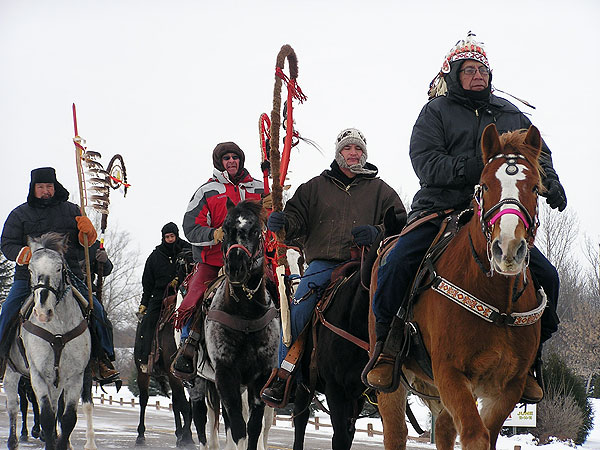
Photo courtesy of MPR
Minnisota Public Radio has images from the ride, an audio broadcast and blog post about:
The 300 mile of reconciliation over the mass hanging of Dakota people in 1862.
'The group has endured blizzards and long stretches of below zero temperatures in their journey from the Missouri River to the Minnesota River.
'They saddled up again this morning in southwest Minnesota for one of the last legs of what they call a ride of reconciliation.
'St. Paul, Minn. — About two inches of overnight snow was waiting for the riders as they assembled on the wacipi, or powwow grounds, of the Lower Sioux Community. Trailers, pickup trucks and dozens of people were on hand to help feed, water and brush the horses.
'One of the people saddling up is Jim Miller. Miller lives on the Pine Ridge reservation in western South Dakota. He says despite the rough weather, the riders enthusiasm is undiminished.
'Jim Miller: "I'm amazed at the young guys," Miller says. "They're up and ready to go. We as the elders, we kind of have to talk them down, you know? They wanted to ride in the blizzard, they're just game."
'Miller says he started the ride in 2005 after dreaming about a riderless horse and other symbols he linked to the mass execution in Mankato. An ancestor of his was among those executed.
'The hangings followed the Dakota-U.S. War of 1862 which began just a couple miles away from where Miller stands. On Dec. 26, 1862, victorious federal officials hanged 38 Dakota men as punishment for a war that took hundreds of lives.
'Miller says the pain of that conflict still linger among families on both sides of the war.
'"I want to make a statement that we're the first to apologize, for our part in the war," Miller says. "What the federal government and what the state does is up to them. And we're here on one condition, and that's love for all people. We have to share this planet together and let's do it with love."
'Miller's message of reconciliation is what the event is all about -- bridging gaps between cultures. Miller says when a blizzard stranded the riders for two days in Howard, S.D., the residents he calls non-natives helped out, providing extra feed for the horses.
'In southwest Minnesota, Theresa Welu says her family agreed to put the riders up for a night on their farm near the town of Milroy.
'Theresa Welu: "They were so set on making something better," Welu says. "And their message of peace and hope and strength and trying to help their people reconcile with everyone else, it was just a wonderful thing and we were so glad to play a small part in their ride through here."
'Back on the Lower Sioux, the riders are leaving the powwow grounds, ready to travel county roads on the day's planned 18-mile trip.
'The area was the homeland for the Dakota before the 1862 war. The war started after the U.S. government failed to meet its treaty obligations.
'After the war, the Dakota were driven out of Minnesota, resettling mainly in Nebraska, South Dakota, North Dakota and Canada.
'Yvonne Wynde's family was among those forced out. Today, her grandson's are among the riders. She says she hopes they learn a little history on the journey.
'Yvonne Wynde: "To see all these names, Lac Qui Parle, Birch Coulee, Wood Lake; what happened here? Really want to become better educated in terms of the American public educational system and the Dakota educational system that I think happens more in the homes than in the schools," says Wynde.
'Wynde says the effects of the 1862 war still linger today, not only in the displacement of the Dakota people, but also in the poverty that followed.
'Once the riders are on the road through Lower Sioux, the history Wynde is interested in is all around.
'They pass by the warehouse where the fighting started in 1862. They'll spend the night at Fort Ridgely, scene of a major battle in the war. Then it's on to Mankato. The group will hold a ceremony there Friday near the execution site.
'More than a decade ago the city renamed the location Reconciliation Park.'
No comments:
Post a Comment